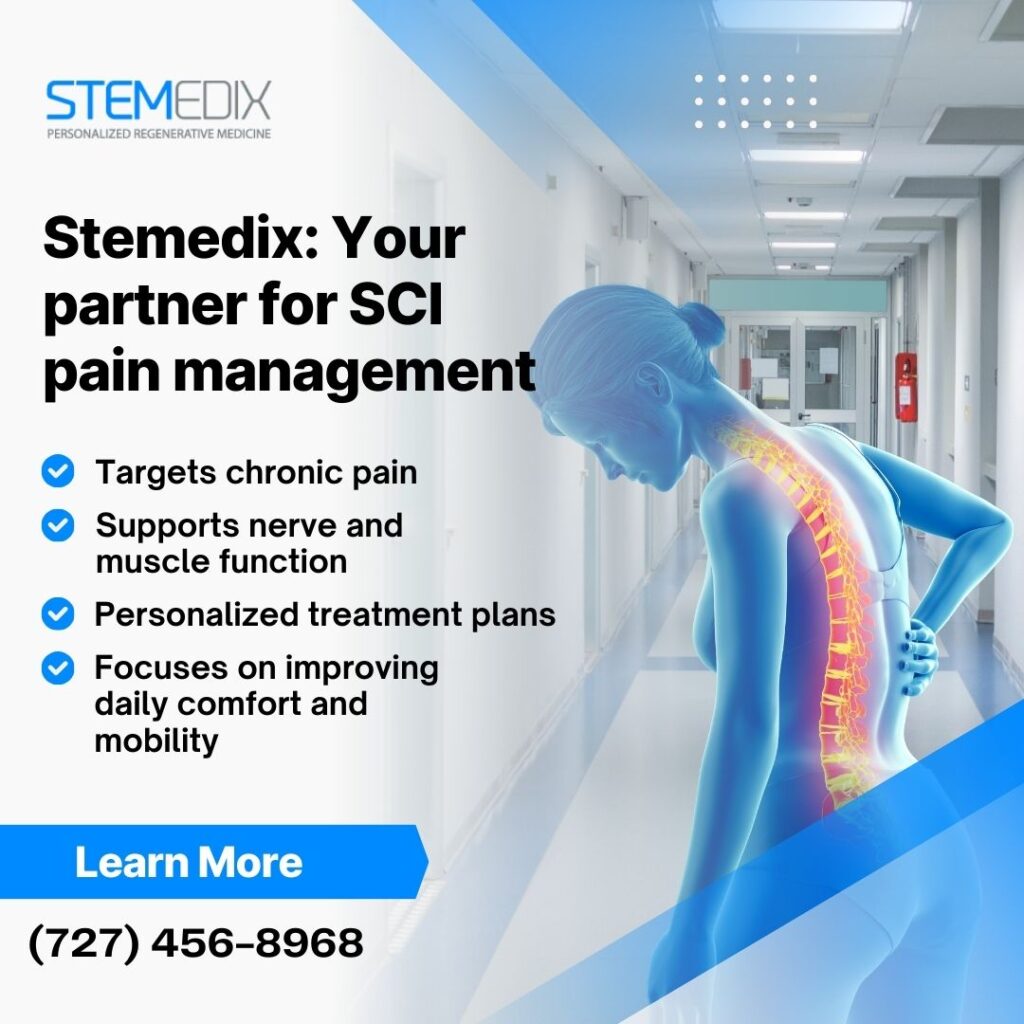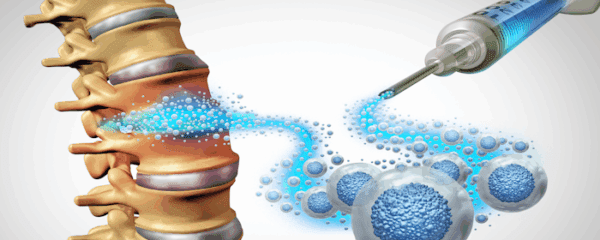Living with a spinal cord injury can bring persistent pain, muscle tension, and challenges in daily activities. At Stemedix, we specialize in stem cell therapy for spinal cord injury, offering individualized treatment plans designed to help you manage these symptoms and support your body’s natural repair processes. Our approach uses stem cells for the treatment of spinal cord injury to target inflammation, improve nerve function, and promote neural cell activity. While this therapy does not reverse the injury, it can provide meaningful improvements in circulation, motor control, and muscle strength.
By leveraging stem cell treatment for spinal cord injury, our team helps you explore alternative regenerative options tailored to your specific condition. From reviewing your medical records to developing a personalized therapy plan, we make sure that you receive focused care and support throughout your regenerative medicine journey in Saint Petersburg, FL.
Spinal Cord Injury and Its Link to Chronic Pain
A spinal cord injury can have long-lasting effects on your body, impacting movement, sensation, and daily activities. Chronic pain often becomes a persistent challenge for those living with SCI, affecting quality of life.
What Happens in a Spinal Cord Injury
A spinal cord injury (SCI) disrupts communication between the brain and the body. The spinal cord serves as a critical network that transmits signals controlling movement, sensation, and organ function. When this pathway is damaged, signals may be blocked or misdirected. Patients often experience numbness, weakness, or loss of coordination depending on the injury location. Traumatic events such as motor vehicle accidents, falls, or acts of violence are common causes of SCI.
Types of Spinal Cord Injuries (Complete vs. Incomplete)
Complete injuries cause total loss of sensation and function below the injury site, while incomplete injuries leave some signals intact. For example, a complete cervical injury may result in paralysis of both arms and legs, affecting your ability to perform basic tasks. In contrast, an incomplete thoracic injury may allow partial movement or sensation, letting patients retain some independence in daily activities. Injury classification also influences potential treatment outcomes and how rehabilitation and therapies, including stem cell approaches, may support recovery.
Why Chronic Pain Develops After SCI
Chronic pain develops because damaged nerves send abnormal signals to the brain. After an injury, nerve fibers may misfire, creating ongoing pain sensations even in the absence of an external trigger. In addition, muscle spasms, stiffness, and localized inflammation can worsen discomfort. Individuals with SCI report chronic neuropathic or musculoskeletal pain, underscoring the need for supportive interventions to manage symptoms and improve daily function.

Stem Cell Therapy for Spinal Cord Injury: An Overview
Stem cells for the treatment of spinal cord injury are an option that targets the damaged areas of the spinal cord to improve function and reduce chronic pain. This therapy is designed for patients who already have a confirmed spinal cord injury diagnosis and are exploring regenerative approaches to support recovery.
What Stem Cell Treatment for Spinal Cord Injury Means
Stem cell therapy for spinal cord injury uses regenerative cells to support repair processes in damaged tissue. These cells work by modulating inflammation, helping damaged nerve tissue survive, and supporting the activity of neural cells. Introducing regenerative cells into injured areas may reduce muscle spasms, improve motor function, and promote better communication between the brain and body.
Types of Cells Studied for SCI (Mesenchymal Stem Cells and Neural Cells)
Two cell types often studied in stem cells for the treatment of spinal cord injury are mesenchymal stem cells (MSCs) and neural cells.
- Mesenchymal stem cells (MSCs) release growth factors that regulate inflammation and support tissue repair. In patients with spinal cord injury, MSCs have been observed to reduce swelling around damaged nerves and support partial recovery of muscle function. Clinical observations suggest that MSC therapy can lead to measurable improvements in the motor function of patients, depending on the location and severity of the injury.
- Neural cells contribute to nerve pathway repair and enhance communication between the spinal cord and brain. By supporting damaged neurons and promoting nerve signaling, neural cells may improve voluntary movement and reduce chronic pain. Early studies indicate that introducing neural cells in injured spinal regions can aid in reestablishing motor and sensory pathways in cases of incomplete injuries.
How Stem Cells May Help Manage Chronic Pain in SCI Patients
Chronic pain after a spinal cord injury affects multiple aspects of your daily life, from mobility to sleep and overall comfort. Stem cell therapy for spinal cord injury offers potential pathways to address these challenges by targeting the underlying cellular processes involved in pain and tissue repair.
Reducing Inflammation and Muscle Spasms
Stem cells may help calm inflammation that contributes to pain and spasticity. Mesenchymal stem cells (MSCs) used in stem cell treatment for spinal cord injury release signaling molecules called cytokines that influence immune activity around damaged nerves. These molecules can lower nerve hyperactivity and ease continuous muscle tension. Patients receiving MSC therapy often report noticeable reductions in spasticity and localized inflammation within weeks of treatment, contributing to less discomfort during movement and rest.
Supporting Nerve Repair and Neural Cell Activity
Stem cells may aid in nerve protection and regeneration. Both MSCs and neural cells in stem cell therapy for spinal cord injury can support damaged neurons, helping them survive and re-establish connections. Improved neuronal connectivity can restore signal transmission between the brain and affected regions of the body. Even partial recovery of nerve function can lead to measurable improvements in motor control and a reduction in neuropathic pain.
Improving Circulation and Motor Function
Stem cells may promote better blood flow to injured tissues. Enhanced circulation helps deliver oxygen and nutrients to areas affected by spinal cord injury, which may decrease discomfort and support voluntary movement. Patients with incomplete injuries often experience improved coordination and mobility after receiving stem cell treatment for spinal cord injury, with some reporting measurable gains in range of motion and functional independence.
Enhancing Muscle Strength and Daily Function
Stem cell treatment may help reduce muscle wasting and weakness. Strengthening muscles that have weakened due to spinal cord injury can decrease the risk of secondary pain caused by compensatory movements. Patients receiving stem cell therapy for spinal cord injury have reported increased control over previously weakened muscles, less stiffness, and greater ease in performing daily tasks such as standing, reaching, or transferring from a wheelchair.
The Patient Experience at Stemedix in Saint Petersburg, FL
Every patient’s journey through regenerative medicine is unique, and the experience at Stemedix is designed to provide clarity and support at every step. From initial contact to treatment completion, the focus is on helping you navigate your spinal cord injury care smoothly.
Treatment for Patients With a Confirmed Diagnosis
We provide regenerative treatments only for patients with confirmed spinal cord injury diagnoses. We do not perform diagnostic tests or imaging; instead, we build therapy plans using the medical records you provide. This approach allows us to concentrate on developing a stem cell therapy plan for spinal cord injury that aligns with your specific condition and history. By focusing on patients who already have a diagnosis, the treatment is tailored to address ongoing symptoms such as chronic pain, muscle tension, and reduced motor function.
Review of Medical Records and Candidacy Process
Patients provide recent scans, MRIs, and lab reports to determine treatment suitability. If your records are older than a year or incomplete, we can coordinate the collection of updated documentation through a simple medical release form. This process allows our physicians to evaluate the information and determine if a personalized stem cell treatment for spinal cord injury plan may benefit your condition. Early patient data indicate that having accurate, current records improves the precision of therapy planning, which may support better management of chronic pain and muscle function.
Personalized Care and Concierge Services
We offer a full-service experience tailored to patient comfort. Your care coordinator arranges travel from the airport, provides mobility aids like wheelchairs, walkers, or shower chairs, and provides accommodations during your stay. This level of support allows you to focus on your treatment without additional logistical concerns. Patients undergoing stem cell therapy for spinal cord injury at Stemedix report that having these services available contributes to a smoother experience and greater adherence to therapy schedules.

Is Stem Cell Therapy Right for You?
Deciding on stem cell therapy for spinal cord injury involves careful consideration of your medical history and current condition. Knowing what the treatment involves and how it may support symptom management can help you take the next step in your care journey.
Who May Qualify for Treatment
Candidates generally have a confirmed spinal cord injury diagnosis and ongoing symptoms. Patients with chronic pain, muscle stiffness, or reduced mobility due to spinal cord injury may explore stem cell treatment for spinal cord injury as a potential option. Medical records, including MRI reports, blood work, and prior imaging, are reviewed to determine suitability. If these records are older than a year, new evaluations may be requested to provide accurate insight.
Carefully selected patients receiving stem cell therapy for spinal cord injury may experience improvements in muscle function, circulation, and a reduction in chronic pain, highlighting the role of targeted regenerative therapy in managing long-term symptoms.
The Role of Care Coordinators in Your Journey
Our Care coordinators guide patients through every step of the process. They assist in gathering and reviewing medical documentation, explain each aspect of the treatment plan, and coordinate travel, accommodations, and equipment if needed. Their role also includes addressing questions about the therapy process, treatment frequency, and expected outcomes.
Coordinators help schedule appointments and communicate with the physician team to tailor the plan to your specific condition. This structured approach helps maintain clarity and support throughout the therapy process.
Begin Your Regenerative Medicine Journey With Stemedix
Take the next step in managing your spinal cord injury with personalized care. Stemedix offers tailored treatments for spinal cord injury in Saint Petersburg, FL, designed around your medical history and current needs.
You can speak directly with our care team to discuss your condition, review your medical records, and explore treatment options. Call us today at (727) 456-8968 or email yourjourney@stemedix.com to start your personalized therapy plan.


 St. Petersburg, Florida
St. Petersburg, Florida
